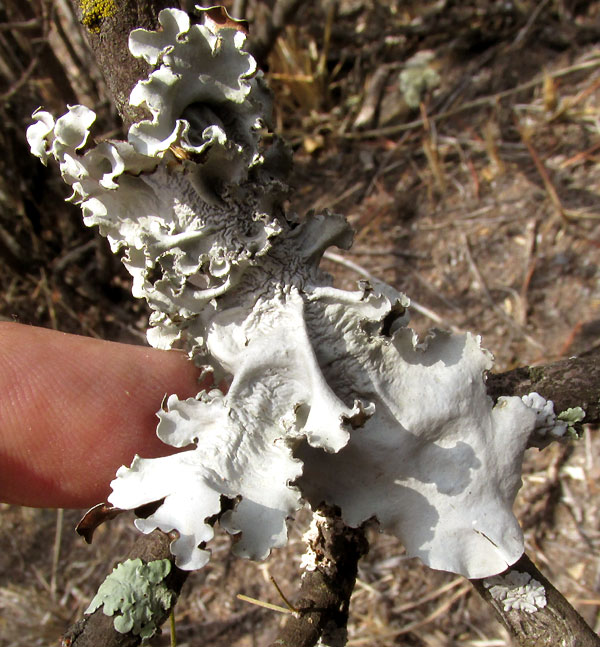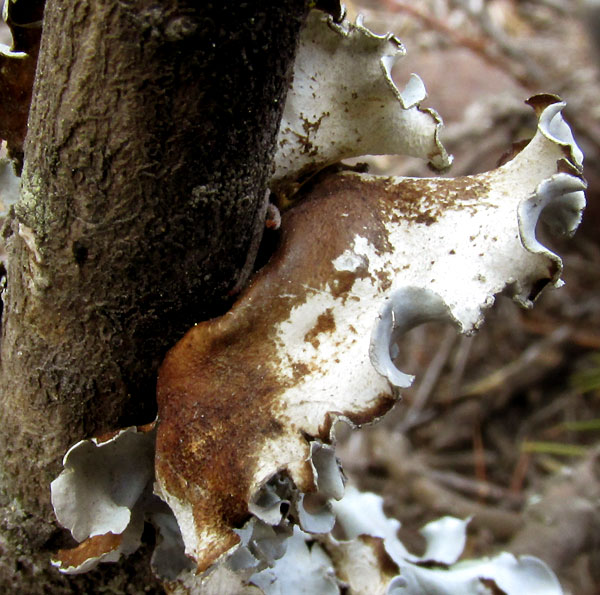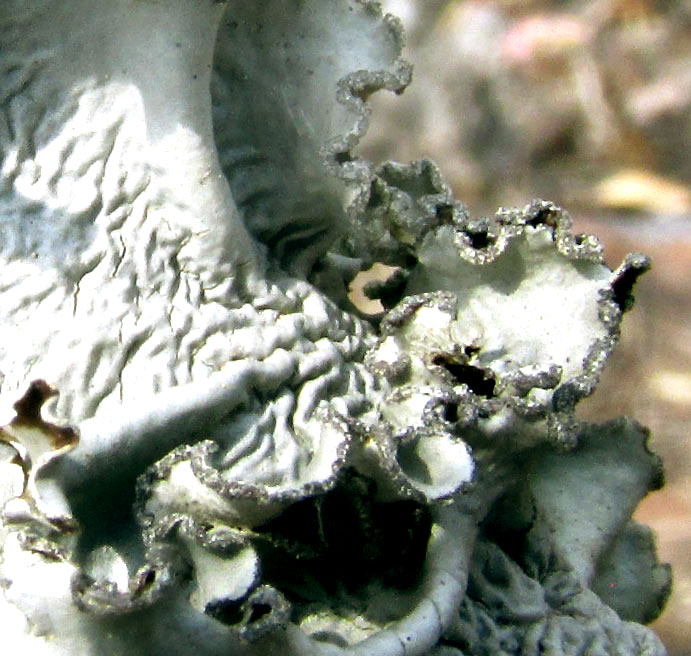Excerpts from Jim Conrad's
Naturalist Newsletter
entry dated April 6, 2023, with notes from the lower slope of hill south of El Cerrito, 5kms south of Tequisquiapan; bedrock volcanic andesite, an intermediate rock between basalt and rhyolite; elevation about 2,000m (6600 ft), Querétaro state, MÉXICO
(~N20.47°, ~W99.89°)
COMMON GREENSHIELD LICHEN

On the grossly overgrazed, eroded lower slope of the ridge south of El Cerrito, the above foliose lichen was common on twigs and trunks of mesquite, Prosopis laevigata. Notice smaller lichen bodies of the same species establishing on twigs at the picture's bottom. The occurrence of various lichen species on trees and rocks in this immediate area was striking, because only about 100m lower (330ft) few lichens were to be seen, and none as large as this one. Possibly on this slope air currents begin rising to cross the ridge and, in cooling, enough moisture condenses to encourage lichens.
Besides its relatively large size, noteworthy field marks for this lichen include: the lack of spore-producing apothecia; large, whitish surface areas with no apparent structures or features at all; thallus lobes extending freely away from the twig, and; the frilly lobe margins. Also, note that where the thallus anchors on twig surfaces, the thallus puckers into crowded wrinkles -- it becomes "rugose."

As seen above, bending a longer lobe away from its twig exposed on the thallus undersurface a well defined dark brown area. Such brown-blotched bottoms were seen on other thalli as well, and on younger plants the brownness extended to the thallus margins.

Closer up, thallus margins were grainy, with what I assume to be soredia, each grain of which contains several cells of both the lichen's fungal hyphae, and the photosynthesizing cells of an alga and/or a cyanobacterium. Broken off soredia can be transported by wind, water or animals, or just knocked off as a twig shakes in the wind. The small lichens below the big one in the top picture may have sprouted from the large lichen's soredia, and thus would be genetically identical.
In some parts of the world field guides are available for lichen identification, but not in Mexico. Still, this lichen was relatively easy to name by doing an Internet image search on the keywords "lichen white foliose tree Mexico." In such a way, among many resulting thumbnail images, one species looked exactly right, and it turned out to be a commonly occurring one throughout most of the world, including Mexico. That species was FLAVOPARMELIA CAPERATA, in English mostly known as the Common Greenshield Lichen.
The "green" part of its name becomes understandable in individuals growing in shade, which are described as green-gray. Apparently, the less sunlight this lichen has, the more green, photosynthesizing "photobionts" it produces relative to the density of its white fungal hyphae. In lichen bodies, the photobionts are provided by various species of green algae and/or cyanobacteria, which are enmeshed in white, threadlike fungal hyphae. Fungal hyphae give the lichen form, and enable it to reproduce sexually. In Common Greenshield lichens the photobiont is a unicellular green alga in the genus Trebouxia, which can survive independently as a free-living organism, though it's the most common photobiont in existing lichen species.
Apparently our lichen predominantly reproduces asexually, since its disc-like apothecia are rarely produced, as with ours on the mesquite. Apothecia produce spores by sexual means.
Common Greenshields are less vulnerable to air pollution than most lichen species, so in areas with moderate air pollution often it's one of the few surviving lichens.
Common Greenshields are widely used in traditional medicines worldwide. In the 2017 study by Vinod Kumar and others entitled "In vitro Antibacterial Activity of Himalayan Lichenized Fungi," it's said that in the Kumaun region of the Indian Himalayas, Flavoparmelia caperata is employed as a carminative (against farting and intestinal gas), as an aphrodisiac, and is used against intestinal worms and burns. They tested the lichen against five pathogenic bacteria, and extracts from our lichen exhibited activity against all the bacteria.
In the 2022 book Advances in Phytochemistry, Textile and Renewable Energy Research for Industrial Growth, a chapter by Linet Jelagat and others describes testing extracts from Flavoparmelia caperata for use as dye. Extracts were acquired both by boiling the lichen in water and using the ammonia fermentation method. Boiling in water produced a brown dye, while ammonia fermentation made a purple one, which darkened on using vinegar as a mordant. The conclusion was that our lichen "... can be a source of natural dyes with good colour fastness properties to light, rub, and wash."